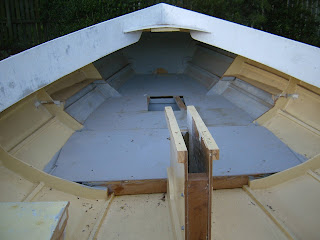The clamps are holding doubler strips to the backs of the remains of the original panels. Tomorrow's job is to shape the plywood panels for the new front and top of the seat. I will glue the seat front in place and then paint the inside of the compartment before glueing the top down (epoxy on the bare wood then paint over everything).
The original mast step was on the keel and I am moving it up onto the seat top. The new plywood spine betweem bulkheads 2 and 3 has substantial ribs either side of it to support the load from the mast. The heavy ply top to this spine will transfer the longitudinal forces to the two bulkheads and the seat top, when it is glued down, will handle the transverse loads. This ply top will also be connected to the centreboard case by a continuation of the vertical spine and a horizontal "beam".
The photo below shows the original hole in the deck that the mast fitted through. It is plugged because it is about 50 mm forward of where it should be (click on the photo to enlarge it and you will see my marks showing where the centre of the hole should be). I will shape a piece of ply to glue down onto the deck and then cut a U shaped opening so the mast can be stepped and pushed up into the U without having to lift it to the vertical and pass it down through the hole in the deck.


















